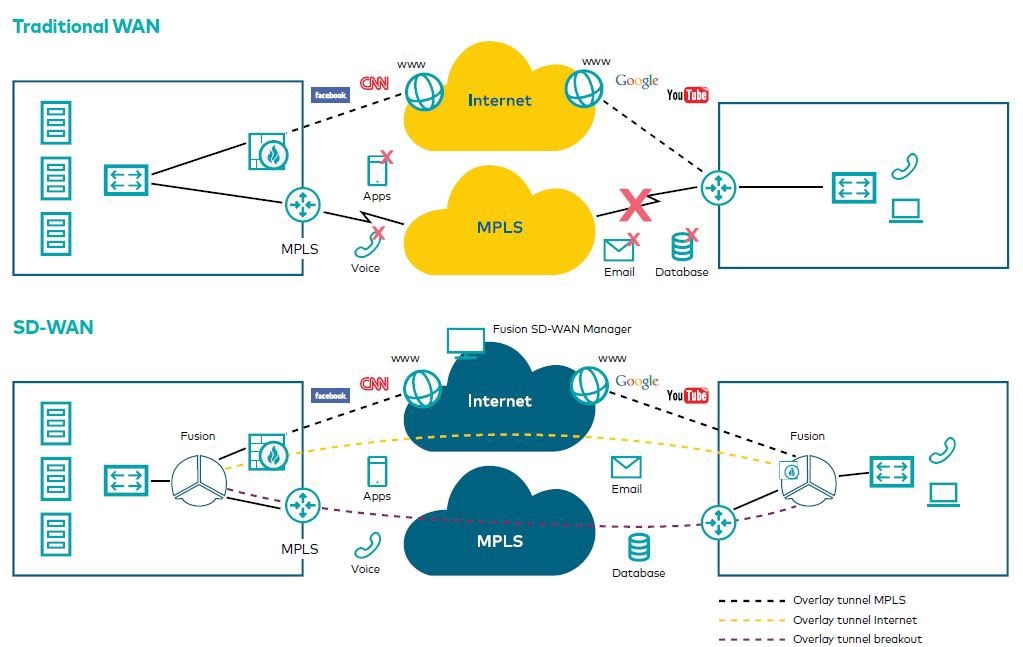The software-defined wide area network (SD-WAN) is a technology for configuring and implementing an enterprise WAN — based on software-defined networking (SDN) — to effectively route traffic to remote locations such as branch offices. SD-WAN technology derives significant flexibility and agility benefits from removing the burden of traffic management from physical devices and transferring it to software — the essence of SDN.
In 2019, it has become clear that SD-WAN has secured its position as the way forward for enterprise WAN connectivity. Market adoption is growing rapidly, and industry experts have declared a winner in the SD-WAN vs MPLS debate. For example, Network World called 2018 the year of SD-WAN, and before the end of Q3 2018 Gartner declared SD-WAN is killing MPLS.
How One AI-Driven Media Platform Cut EBS Costs for AWS ASGs by 48%

In this article we’ll discuss top business benefits of SD-WAN.

How does SD-wan work?
SD-WAN works by separating applications from the underlying network services with a policy-based, virtual overlay. This overlay monitors the real-time performance characteristics of the underlying networks and selects the optimum network for each application based on configuration policies.
Where software-defined networking (SDN) deployed in a service provider network enables flexible deployment and usage-based solutions between high capacity sites (like headquarters and data centers) SD-WAN services help optimize traffic flows for performance and cost at branch sites.
By replacing traditional branch routers with appliances that assess and utilize different transport technologies based on their performance, it allows enterprises to route large portions of their traffic over cost-effective services, such as broadband.
The main goal of SD-WAN (SDWAN) technology is to deliver a business-class, secure, and simple cloud-enabled WAN connection with as much open and software-based technology as possible.
Different Types of SD-WAN Architectures
Although the SD-WAN packages you can avail from service providers vary, they often fall under three architecture types:
On-Prem SD-WAN
SD-WAN deployed exclusively on-premises is less expensive than other architectures since it can only establish connections between remote sites and not cloud services. A use case for this SD-WAN architecture is with companies that host most — if not all — of their business applications locally.
Cloud-Enabled SD-WAN
As the name suggests, a cloud-enabled SD-WAN solution can take advantage of cloud gateways to communicate with your cloud applications. This could be anything — from your cloud-based CRM software to office applications.
Cloud-Enabled plus Backbone
In addition to the benefits of cloud-enabled SD-WAN, a “cloud-enabled plus backbone” SD-WAN solution capitalizes the service provider’s nearest Point of Presence or POP. This could be the SD-WAN company’s high-speed, fiber-optic line, which could give your network performance a significant boost.

Now let’s take a look at SD-WAN benefits.
Reduced WAN costs
MPLS bandwidth is expensive. On a “dollar per bit” basis, MPLS is significantly higher than public Internet bandwidth. Exactly how much more expensive will depend on a number of variables, not the least of which is location. However, the costs of MPLS aren’t just a result of significantly higher bandwidth charges. Provisioning an MPLS link often takes weeks or months, while a comparable SD-WAN deployment can often be completed in days. In business, time is money, and removing the WAN as a bottleneck can be a huge competitive advantage.
Enhanced WAN performance
SD-WAN can be configured to prioritize business-critical traffic and real-time services like Voice over Internet Protocol (VoIP) and then steer it over the most efficient route. By facilitating critical applications through reliable, high performance connections, IT teams can help reduce packet loss and latency issues, thereby improving employee productivity and boosting staff morale.
Improved network security
While traditional WAN solutions handle security through multiple appliances at each branch office, SD-WAN has inbuilt security protocols. SD-WAN solutions have built-in encryption capabilities, ensuring that only authorized users are able to access and view assets connected to the corporate network.
SD-WAN also facilitates granular control and enables companies to create policies to inform the network how certain types of traffic should be treated, keeping high-risk traffic from ever entering the network in the first place
Increased WAN availability
While MPLS has a solid reputation for reliability, it isn’t perfect and can fail. Redundancy at the MPLS provider level is expensive and can be a pain to implement.
SD-WAN makes leveraging different transport methods easy, thereby enabling high-availability configurations that help reduce single points of failure. If your fiber link from one ISP is down, you can failover to a link from another provider
Lowers WAN OpEx and CapEx costs
Realizing ROI for Software-Defined Networking in the campus LAN or even the data center has proven elusive. But not so with SD-WANs. The ROI is dramatic and immediate. With an SD-WAN solution you can now augment or even replace MPLS connections with broadband internet services to connect users to applications and lower WAN costs dramatically.
A simplified, centrally managed SD-WAN architecture also lowers OPEX. Bringing a new branch or remote location online is easy and can be done in just a few minutes. No specialized IT expertise is required on premise at the branch.
Greater business agility
Another key selling point of SD-WAN services is increased network performance and agility. Since SD-WAN can automatically funnel your traffic through the fastest and most reliable connection, common network issues such as jitter and latency are considerably reduced.
SD-WAN facilitates the rapid deployment of WAN services, such as bandwidth and firewall. As a result of this, businesses can distribute operations to branch sites without the need to send IT personnel. Bandwidth can also be added or reduced easily as business requirements evolve, giving businesses extra agility to stay ahead of competitors.
Conclusion
While legacy WAN has had its place as a business solution, it’s no longer viable due to increased costs, degraded cloud performance and limited agility. SD-WAN is a much better option.
GlobalDots offers a solution that helps enterprises have all the advantages of a SD-WAN, without the limitations. It’s a secure, cloud-based SD-WAN as a service with built-in global backbone and integrated security.
If you have any questions about how we can help you connect all your business resources and data centers into a secure, unified network, contact us today to help you out with your performance and security needs.






